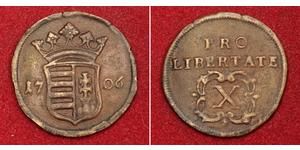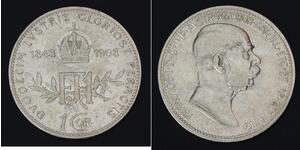(sold for $18.0)
1708, Electoral Paletinate (Pfalz), Johann Wilhelm II. Silver 2 Albus Coin. aXF!
Mint Year: 1708 Denomination: 2 Albus Mint Place: Heidelberg Reference: Noss 335, KM-144 ($60 in VF!) Condition: Mint-made planchet imperfections (impurities in the silver alloy), otherwise about XF! Diameter: 23mm Weight: 1.85gm Material: Silver
Obverse: Crowned heraldic rampart lion of Paletinate left, flanked by initials (C-P). All within wreath. Reverse: Value numeral (*II*) above denomination (ALBUS), date (1708) and mint master´s initials (IMW). All within wreath.
The County Palatine of the Rhine (German: Pfalzgrafschaft bei Rhein), later the Electorate of the Palatinate (German: Kurfürstentum von der Pfalz) or simply Electoral Palatinate[1] (German: Kurpfalz), was a territory in the Holy Roman Empire (specifically, a palatinate) administered by the Count Palatine of the Rhine. Its rulers served as prince-electors (Kurfürsten) from "time immemorial", were noted as such in a papal letter of 1261, and were confirmed as electors by the Golden Bull of 1356.
The fragmented territory stretched from the left bank of the Upper Rhine, from the Hunsrück mountain range in what is today the Palatinate region in the German federal state of Rhineland-Palatinate and the adjacent parts of the French regions of Alsace and Lorraine (bailiwick of Seltz from 1418 to 1766) to the opposite territory on the east bank of the Rhine in present-day Hesse and Baden-Württemberg up to the Odenwald range and the southern Kraichgau region, containing the capital cities of Heidelberg and Mannheim.
The Counts Palatine of the Rhine held the office of Imperial vicars in the territories under Frankish law (in Franconia, Swabia and the Rhineland) and ranked among the most significant secular Princes of the Holy Roman Empire. Their climax and decline is marked by the rule of Elector Palatine Frederick V, whose coronation as King of Bohemia in 1619 sparked the Thirty Years' War. After the 1648 Peace of Westphalia, the ravaged lands were further afflicted by the "Reunion" campaigns launched by King Louis XIV of France, culminating in the Nine Years' War (1688–97). Ruled in personal union with the Electorate of Bavaria from 1777, the Electoral Palatinate was finally disestablished with the German mediatization in 1803.
Johann Wilhelm II, Elector Palatine ("Jan Wellem" in Low German, English: "John William"; 19 April 1658 – 8 June 1716) of the Wittelsbach dynasty was Elector Palatine (1690–1716), Duke of Neuburg (1690–1716), Duke of Jülich and Berg (1679–1716), and Duke of Upper Palatinate and Cham (1707–1714). From 1697 onwards Johann Wilhelm was also Count of Megen.
He was the son of Count Palatine Philip William of Neuburg and Elisabeth Amalie of Hesse-Darmstadt and was born in Düsseldorf, where he resided, rather than in Heidelberg, which had been largely destroyed by French troops during the Nine Years' War. He was educated by the Jesuits and in 1674 he made a grand tour to Italy.
He married Archduchess Maria Anna of Austria in 1678. She was a daughter of Ferdinand III, Holy Roman Emperor and his third wife Eleanor of Mantua. After her death in 1689, he married Anna Maria Luisa de' Medici, the daughter of Cosimo III de' Medici, Grand Duke of Tuscany. His brother was Franz Ludwig, Count Palatine of Neuburg, his sisters were married to Holy Roman Emperor Leopold I, Peter II of Portugal and Charles II of Spain.
His father ceded the duchies of Jülich and Berg to him in 1679, before he also succeeded him as Elector Palatine in 1690. In the Peace of Rijswijk (1697), he was restored to many of the possessions which had been taken by the French, with the provision that the Electorate of the Palatinate not revert to Protestantism. This provision did not make him popular in the Palatinate and with Protestants.
During the War of the Spanish succession Johann Wilhelm received also the Bavarian Upper Palatinate, which was returned to Bavaria in 1714. He died in Düsseldorf and was buried in the St. Andreas Church. Having no son, Johann Wilhelm was succeeded by his brother Charles III Philip, Elector Palatine.
He was more popular in Jülich-Berg, where he erected impressive buildings such as the Schloss Bensberg and led a lavish court which gave work to many artists and artisans, including the court painters Johannes Spilberg, his daughter Adriana, her later husband Eglon van der Neer, Adriaen van der Werff, Jan Frans van Douven, Herman van der Mijn, Jan van Nickelen, his daughter Jacoba Maria van Nickelen, her husband Willem Troost, Rachel Ruysch, Godfried Schalcken and Jan Weenix with his daughter Maria Weenix.[1] His enormous collection of paintings by Rubens can still be seen in the Alte Pinakothek in Munich.
His widow Anna Maria Luisa was the last scion of the House of Medici. A patron of the arts, she bequeathed the Medici's large art collection, including the contents of the Uffizi, Palazzo Pitti and the Medicean villas, which she inherited upon her brother Gian Gastone's death in 1737, and her Palatine treasures to the Tuscan state, on the condition that no part of it could be removed from the capital Florence. Therefore, these treasures are still to be visited in Florence today.
In Düsseldorf, the Jan-Wellem Square is named after Johann Wilhelm.

|
Posted by:
anonymous 2018-07-09 |
1 Corona Austria-Hungary (1867-1918) Silver Franz Joseph I ( ...
group has 25 coins / 17 prices
⇑
















-300-150-AeIKqUpY7NEAAAFhroEy54Nz.jpg)






